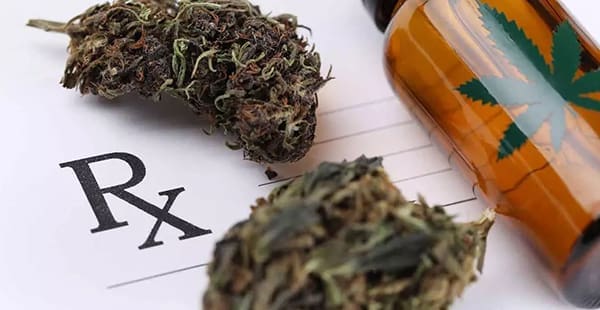What Is Medical Marijuana?
Marijuana comes from the buds and leaves of the cannabis plant. It goes by many names, including pot, grass, cannabis, weed, hemp, hash, marihuana, ganja and dozens of others. Marijuana has been used in herbal remedies for centuries and scientists have identified many biologically active components in the drug. These components are called cannabinoids and can cause drug-like effects on the body. The two best-studied components are the chemicals delta-9-tetrahydrocannabinol (THC) and cannabidiol (CBD).
Medical marijuana comes in several forms, including:
- Dried leaves or buds for smoking
- Edible products, like cookies, brownies or candies
- Oils for vaporizing or mixing into hot drinks or food
- Creams that can be applied to the skin
- Sprays for your mouth
- Pills and capsules
How Medical Marijuana Eases Treatment Side Effects
Mesothelioma patients can consider the use of medical marijuana to ease the symptoms of both their cancer and their traditional treatment plan prescribed by their doctor. For example, THC can help relieve pain, nausea and vomiting, increase appetite, reduce inflammation and ease insomnia. CBD can reduce anxiety and paranoia and can counteract the “high” caused by THC.
A few studies have found that inhaled (smoked or vaporized) marijuana can be a helpful alternative treatment for neuropathic pain or pain caused by damaged nerves. Nerves can become damaged as a result of chemotherapy or other cancer treatments.
Side Effects and Risks
The use of marijuana does come with possible side effects, including:
- Difficulty with concentration and memory
- Dizziness
- Dry mouth and eyes
- Fainting
- Fast heart rate
- Headache
- Increased appetite
- Low blood pressure
The use of marijuana with THC comes with additional possible side effects, including:
- A “high” that can make you feel confused and give you less control over your movement
- Anxiety and paranoia
Although serious adverse side effects are extremely rare, over the long-term, the use of THC may cause mental disorders such as schizophrenia, depression and/or bipolar disorder. It may cause respiratory complications such as chronic bronchitis. It may also impair sleep quality and have long-term effects on learning and recall, especially for anyone under the age of 25.
Medical marijuana doesn’t interact with most drugs used to treat cancer but taking it with two chemotherapy drugs — etoposide (Toposar®, VePesid®, Etopophos®) and paclitaxel (Taxol®, OnxalTM) — can be problematic. It is important the mesothelioma patient speaks with their doctor about any side effects and risks, including drug interactions, associated with medical marijuana before making a decision.
Medical Marijuana Pre-Clinical and Clinical Studies
Pre-clinical studies reported that THC and other cannabinoids such as CBD slow growth and/or cause death in certain types of cancer cells growing in lab dishes. Some animal studies also suggest certain cannabinoids may slow growth and reduce the spread of some forms of cancer. However, the clinical studies done on people so far have shown that cannabinoids can be safe in treating cancer, but they do not show that they help control or cure the disease.
Other clinical trial studies have long shown that people who took marijuana extracts tended to need less pain medicine and had an improved appetite. In short, more studies need to be done on the effects TCH and CDB have on cancer including mesothelioma. Relying on marijuana alone as treatment while avoiding or delaying conventional medical care for cancer such as mesothelioma may have serious health consequences.
Medical Marijuana Approved Drugs
There are two chemically pure drugs based on marijuana compounds that have been approved in the U.S. for medical use.
Dronabinol (Marinol®) is a gelatin capsule containing THC that is approved by the U.S. Food and Drug Administration (FDA) to treat nausea and vomiting caused by cancer chemotherapy.
Nabilone (Cesamet®) is a synthetic cannabinoid that acts much like THC. It can be taken by mouth to treat nausea and vomiting caused by cancer chemotherapy when other drugs have not worked.
Nabiximols is a cannabinoid drug still under study in the U.S. It is a mouth spray made up of a whole-plant extract with THC and CBD in an almost one-to-one mix. It is available in Canada and parts of Europe to treat pain linked to cancer, which is a common symptom of mesothelioma. It is not approved in the U.S. at this time, but it is being tested in clinical trials to see if it can help a number of conditions.
Questions for a Mesothelioma Patient to Ask Their Doctor
Decisions about symptom management through the use of medical marijuana should be made between the mesothelioma patient and their doctor. Some things to consider include:
- Side effects and risks
- Interactions with current or potentially future medication
- Balancing evidence of benefit and harm to the patient
- The patient’s preferences and values
- Any laws and regulations that may apply
Obtaining Medical Marijuana
Although states have passed laws permitting the use of medical marijuana, under federal law, marijuana continues to be an illegal Schedule I drug, meaning that it is considered to have a high potential for abuse and is not recognized for medicinal use. Because of this, federal law prohibits its prescription, and marijuana cannot be used in hospital settings or dispensed at licensed pharmacies. Medical marijuana “prescriptions” are more often called “recommendations” or “referrals” because of the federal prescription prohibition.
Insurance companies do not cover the cost of medical marijuana, but most will cover the use of the pharmaceutical dronabinol (Marinol®), which contains the active component THC.
If the mesothelioma patient lives in a state that has passed a law permitting the use of medical marijuana, they will need to obtain a certification from their doctor. If a certification is obtained it is recommended that the patient research dispensaries carefully.
Ideally, the patient’s healthcare provider will be able to refer the patient to a reputable dispensary. In some states, dispensaries employ pharmacists or well-trained professionals with a health background. Some dispensaries do not have well-trained health professionals, hence the need for careful research.
The patient should ask about an employee’s level of familiarity with using cannabis for cancer patients before deciding if the dispensary is a good fit for them. If the patient feels comfortable with the employee and the establishment, they should tell them about their symptoms and ask them to recommend specific strains and products.
Legality by State
At this time, the U.S. Drug Enforcement Administration (DEA) lists marijuana and its cannabinoids as Schedule I controlled substances. This means that they cannot legally be prescribed, possessed or sold under federal law. Whole or crude marijuana (including marijuana oil or hemp oil) is not approved by the FDA for any medical use. The use of medical marijuana is currently legal under state law in 36 states and four territories. The map below shows the legality status of state cannabis programs.
Last Updated: June 2025
Note: State status reflects current laws at the time of update, not pending legislation or future dates upon which marijuana becomes available medicinally or recreationally.
* Enactment is pending until a future date.
As the laws are fast-changing, you can view an updated map through the National Conference of State Legislators.





